
The mole head pipe today is one of the most effective means of combating moles in gardens, flower beds and gardens of almost any size. However, lovers of scattering poisons, catching moles on fishing hooks or even chopping up animals with a shovel can argue with this, but in this case we suggest first to get acquainted with the advantages of mole traps in more detail.
Note the most obvious advantages of such a trap:
- The efficiency of the mole-catcher-pipe is approximately the same as that of various kinds of traps, strangleholds, traps with fishing hooks and other "live-fishing" devices of lethal or crippling action. As practice shows, a simple, seemingly, piece of pipe allows you to quickly catch all the moles in the area, even if the area is not the smallest;
- Importantly, the mole-head pipe belongs to the humane means of struggle, allowing not to kill moles, but to catch them alive, to take them out of the site and release them;
- The tool works automatically, and is capable of catching several moles at once. The owner of the site only needs to set the mole catcher correctly, regularly check and take away the caught animals away from his garden (we’ll talk a little lower about how far to take away so that the animals do not come back);
- The mole head made of the pipe is very reliable and durable, it is very difficult to break even with not very careful handling.
The photo below shows an example of a homemade molehill from a pipe:
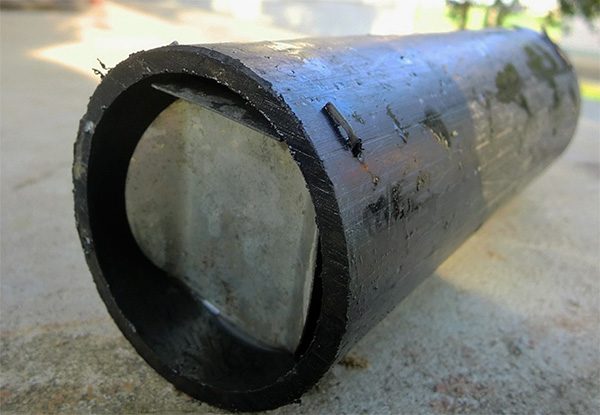
Another advantage of such a trap is its relatively low price. For example, in online stores, even the most advanced collapsible mole head pipe costs about 400 rubles, and a simpler one-piece pipe can be bought at a price of about 200 rubles.
On a note
The unobvious advantages of a mole head tube will become clear only with sufficient experience with the use of alternative means. For example, many people try to scare away moles with rotten herring heads pushed into their passages, but the rotten smell of fish is unlikely to brighten up your stay at the cottage ... Other comrades act even more sophisticatedly by digging human feces into the animals' mink - here, perhaps, you can do without comments. Someone floods the moles with water from a hose, turning their garden into a swamp. Some pour mole heaps with kerosene or white spirit, push carbide into the moves, blow up firecrackers in them, stuff smoke bombs and do a lot more, often without suspecting that an ordinary mole catcher from a pipe, even made by hand, can be many times more effective than all the above methods combined.
We’ll talk in more detail about how to make a mole head from a pipe with your own hands below - it’s really not difficult (drawings and instructions will be given on how to implement such an undertaking).

But first, let's look at the principle of operation of the trap in order to better understand what nuances you need to consider when manufacturing and using it.
The device and principle of operation of the mole head in the form of a pipe
The essence of the work of the mole head-pipe is that the mole can very easily, practically without effort, climb inside it, but it is no longer able to get out. This effect is provided by the special device of the door, working in the pass mode only "at the entrance."
The diagram below shows that the mole trap door has a length slightly larger than the diameter of the pipe, and therefore is in a slightly inclined position, abutting against the bottom of the trap:

As a result, it is impossible to open such a door from the inside, just pushing it, which is what the mole is trying to do.The only way to open the mole trap door is to lift it from the outside:
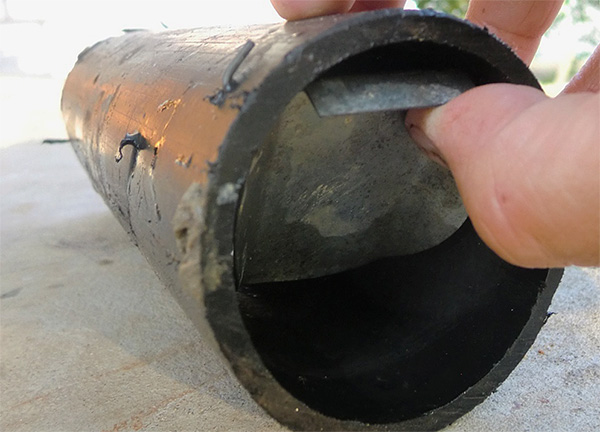
An important point (in case you decide to make the device yourself): the doors should be located at both ends of the pipe, because it is not known in advance which side of the underground passage the animal will be trapped in. In addition, the length of the pipe should not be too small - this is necessary so that, if necessary, several moles fit in it at once. A correctly made mole catcher can catch up to 5 or more animals in one installation (in this case, not only moles, but also mice, shrews, field voles and other animals are usually found).

An important advantage of an industrially manufactured mole head-pipe is the ability to disassemble it: such a mole-head consists of two parts of the same length, which are joined together and are latched with a special lock. This is very convenient when releasing the captured animal at will: the lock opens, the two parts of the pipe disconnect, and the mole is gently shaken to the ground.
If the mole catcher consists of a whole pipe, then to remove the animal from it, you should not open the door with your finger (at least without a glove), since there is a risk that the mole (or another pest that has got inside) will bite you. The photograph below clearly shows that the mole's teeth are sharp enough to provide an unlucky gardener with an unpleasant bite sensation:


Although it may seem that the whole pipe is somewhat more reliable compared to the collapsible design (since there is no lock that could break), in practice, in this regard, there is not much difference, in general, because to break the lock - It is still necessary to try. Thus, perhaps the only significant advantage of a one-piece trap is about half the price.
You can see how the mole-tube-tube works and how the mole gets into it, in the video at the end of this article.
How to set such a trap to accurately catch a mole
The mole tube is installed in the open mole course. It is advisable to dig it out with a small scoop, since the mole is careful not to go into the roughly excavated shovels, which means it will not fall into the trap.
It is not enough to set the mole cat itself, it is also necessary to choose a course suitable for installation. Optimal for this is a well-visible, close to the surface tunnel between two fresh emissions of land. The pipe should not be placed close to the mole heaps themselves, since the mole does not always use such exits to the surface repeatedly. But he inspects the moves themselves, and therefore he will certainly come across a pipe.
So, we establish a mole-tube-pipe: for a start, the “ceiling” is removed from the found underground passage, which often rises slightly above the earth's surface in the form of an extended roller. Then the walls expand a little and the bottom of the course goes deeper so that the pipe becomes exactly in the prepared place, and its axis approximately coincides with the direction of travel. Door hinges should be on top.
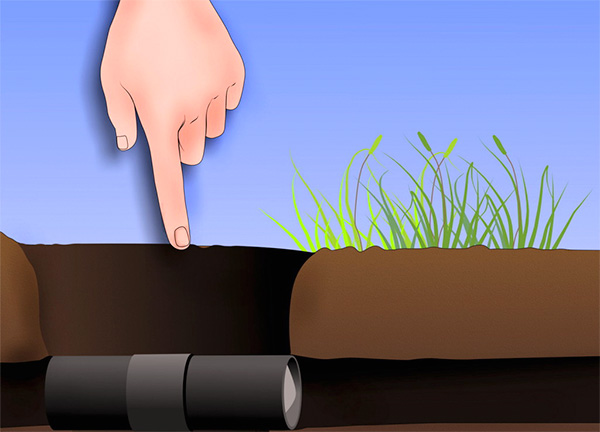
Before entering the pipe, it is very useful to pour a small heap of earth to create for the mole the appearance of collapse of the soil at the bottom of the tunnel. In this case, he will instinctively begin to rake the ground and push forward, in a fuss, not paying attention to the small suspicious flaws that are always present when installing the trap (extraneous odor, unusual damage to the walls of the course, a strange obstacle in the form of a door, etc.)
After installation in the excavated passage, it is necessary to cover the pipe with a wide board, a wooden shield or a dense large piece of cloth from above, so that sunlight does not get here, as it can scare off the mole. You can cover the trap with turf, if it is dense enough.
The mole trap should be checked at least twice a day, and preferably 3-4 times.The fact is that because of the accelerated metabolism, the mole can not do without food for more than 24 hours, and dies during a longer hunger strike. Therefore, you need to remove the animal from the mole catcher as soon as possible after capture and let it go free.
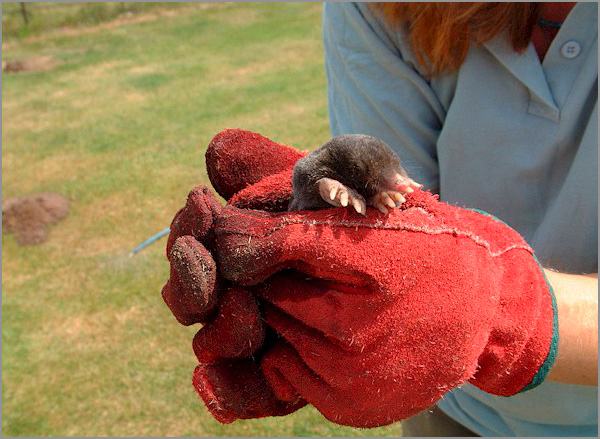
It can be useful to place several earthworms cut into pieces in a mole-tube before installing it. Their smell is attractive to moles and, in addition, such a supply of food will not allow the mole to die of hunger too quickly.
On a note
The collapsible mole head pipe has convenient grooves through which it can be seen whether the mole got into it or not. The animal, when it is inside, constantly sticks its nose out of these grooves, and it is immediately visible. Checking the whole pipe is much more difficult - you need to either listen to it, pressing your ear against the wall, or even pull it out and look into the door that opens.

How to make a mole tube pipe yourself
With your own hands, a mole trap is made from a piece of plastic or metal pipe with a diameter of 9-12 cm and a length of 40-50 cm. Two holes are made along the edges, on which the doors will be hinged.
Below is a drawing of such a mole head:
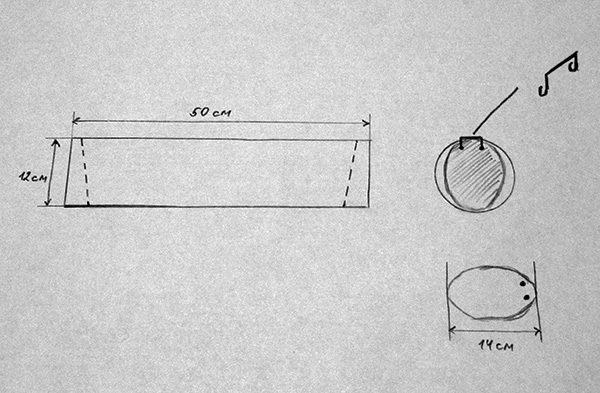
It is advisable to observe the indicated dimensions, since a large individual will not crawl into a too narrow pipe, a short pipe will not accommodate several animals at once, and too wide is inconvenient during installation, since it will not correspond to the average diameter of the mole.
Further:
- Two oval-shaped doors are cut from an aluminum sheet or from the bottom of cans. The major axis should be slightly larger than the inner diameter of the pipe, the smaller axis should be slightly smaller;
- At the top, in the narrow part of each door, two holes are drilled;
- Hinges of wire are inserted into the holes, the door is inserted into the pipe under the inclination of the lower part inward, the loop is put on the hole in the pipe;
- The same thing is repeated with the second door.
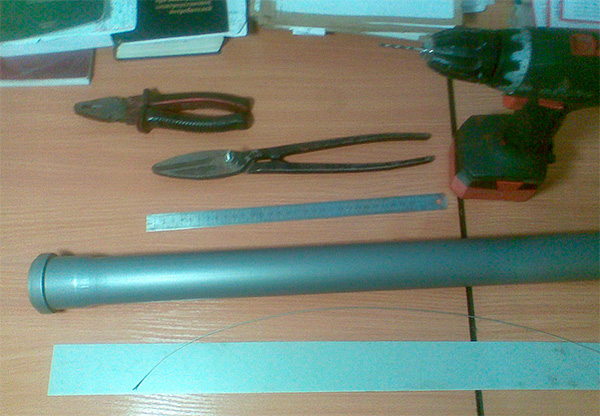
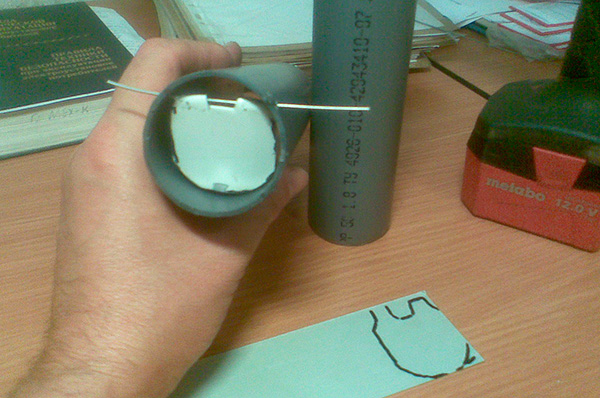
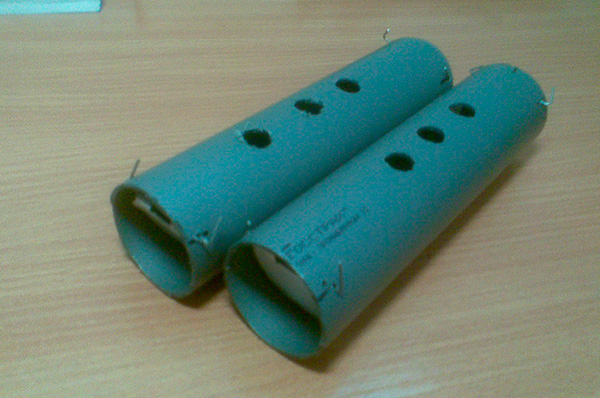
There is also an option where not loops are used, but a nail transversely inserted at the top of the pipe. The door is hung on it due to a special bend, which is done after cutting the door, for example, using pliers.
The following drawing shows a second embodiment of a door:
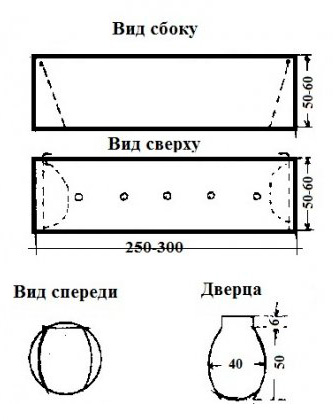
In both cases, it is useful to make several holes with a diameter of about 1.5 cm in the upper part of the pipe - this will allow you to set the trap once and not constantly remove it for inspection - the caught mole will be visible through the holes.

Also very popular is the version of the mole head pipe made of plastic bottles. In this case, not doors are used, but two necks from other bottles. They make 10-12 longitudinal cuts, previously cutting off the solid part, on which the lid is wound. The resulting "petals" work in the door mode, which allows only one direction - the mole gets inside, just pushing it with its body, and can’t push them apart to get out.
Below is a schematic illustration of such a mole head pipe made of three plastic bottles:
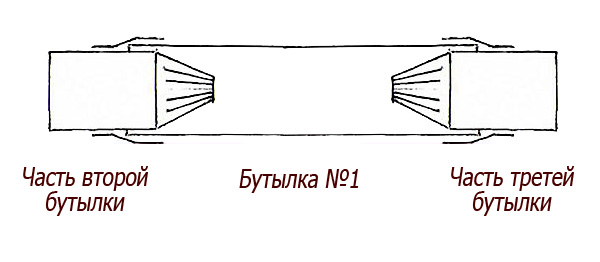
The effectiveness of traps of all these types is approximately the same, if correctly installed.
What to do with a mole after capture?
The caught mole should be attributed approximately 1-1.5 km from the site and released - in this case, the animal will definitely not come back. It is preferable to let the mole out in the thick grass, planting, shrubbery or forest, where it can quickly dig and not be caught by a predator.
If the trap is supposed to be installed immediately again after capture, then the caught animal can be temporarily shaken out in a bucket.
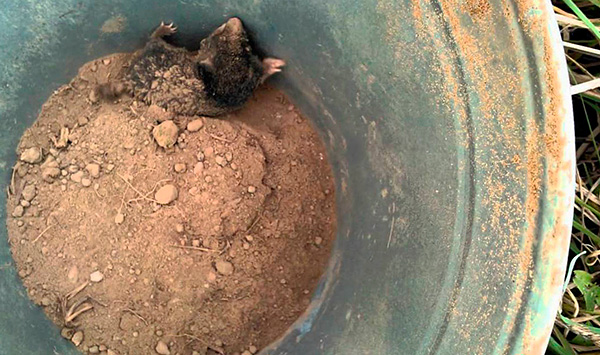
All manipulations with caught moles, as well as mice, rats, shrews, field voles, blind people and other animals, which often also fall into the mole catcher, should be carried out in tight construction gloves. As mentioned above, the mole has very sharp teeth, and in rare cases it can be a carrier of diseases dangerous to humans, so bites should be avoided in every way.
In the ideal case, there is no need to touch the captured animal at all, it simply shakes out of the pipe. If there is a need to take it with his hand, then he grabs either the tail or the scruff of the neck.

It is important to understand that if you do not provide additional measures to protect the site from moles, in most cases the animals will penetrate it periodically again, and they will have to be caught almost every year. For example, a very effective (albeit expensive) way to protect the site from moles is to dig in the ground around the perimeter of the section of fine mesh to a depth of 70-80 cm and a height above ground level of about 20 cm - this will prevent new moles from entering the territory.
Where can I buy a mole head pipe and how much does it cost
The mole tube pipe today can easily be bought in online stores. Many particularly entrepreneurial citizens have mastered the manufacture of their own hands on a semi-industrial scale, and today on sale there are imported quality traps of 400-500 rubles apiece, collapsible and very convenient, as well as handicraft products, somewhat clumsy and not so pleasant to handle. but worth almost half the price.
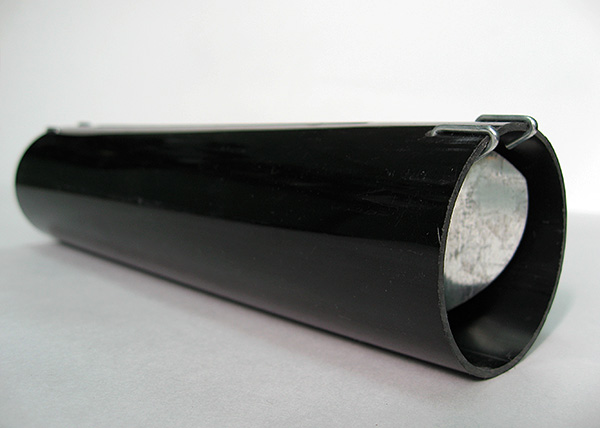
In cities far from Moscow, some online stores deliver such devices by mail or transport company.
For one site with an area of up to 10 acres, it is enough to buy one mole catcher pipe. With the right approach, all the "local" moles come into it quite quickly, and in a few days you can catch all the pests in the area (without forgetting that new moles can replace them after some time).
Other mole traps, their advantages and disadvantages
No less than livestock in the form of a pipe, slightly less convenient methods of catching moles are used: in buckets, deep pots, glass jars or wide plastic bottles with a cut neck. They are buried in the gap of the mole, the edges are covered with a roller from rammed earth, and the opened passage is covered with boards from above so that sunlight does not get into it.

Moving along the way, the mole simply falls into such a devious "hole" and cannot get out of it. When checking the animal, it is taken out with a gloved hand and carried away from the site. This method is also quite effective, although more time-consuming to implement than using a good mole tube-pipe.
Unfortunately, moles are also often killed with special traps (crush, self-arrows, snares ...) Their designs are diverse, but their main drawback is precisely the inhumane destruction of animals that are guilty only of being human neighbors in the area.
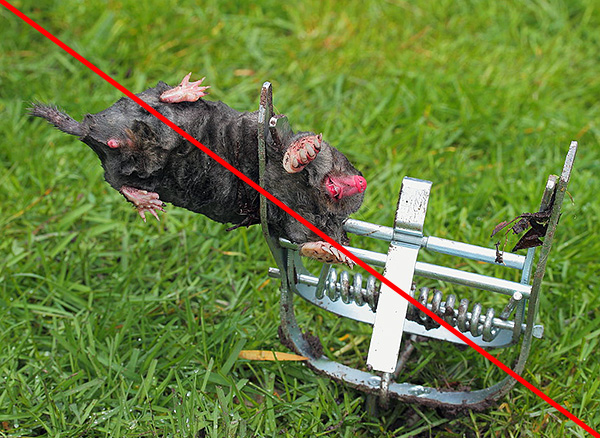
But various methods of scaring away moles are for the most part less effective than traps. Many of them do not always work (for example, noise, as well as rotten fish, perfume, ammonia, carbide), others are harmful to the soil and its inhabitants (pouring kerosene, gasoline into the burrows, falling asleep Alfos tablets, fumigating with insecticidal and sulfur blocks). And the effectiveness of other methods is completely doubtful from the very beginning: sticking reeds into the ground, burying feces in underground passages, etc.
In some cases, good mole repellents are given by special mole repellents (far from all the models on the market). However, read more about repellers in other articles on our website. And before that, do not forget to leave a review about your personal experience with using a mole head pipe, if you have such an experience (to leave a comment, just write it in the comments box at the bottom of this page).
Interesting video: a mole caught in a mole-pipe
Another good example of a molehill made from a piece of pipe




Thank you for the humane way - I’ll definitely try. Good for you!
Did. Installed. I'm waiting. I collect tools ...
The efficiency of the trap pipe is greatly exaggerated. More like an advertisement. The mole clogged the pipe with earth and left. Maybe he didn’t go into the pipe, but maybe he went in and went out, since the door, clogged with earth, remained raised.